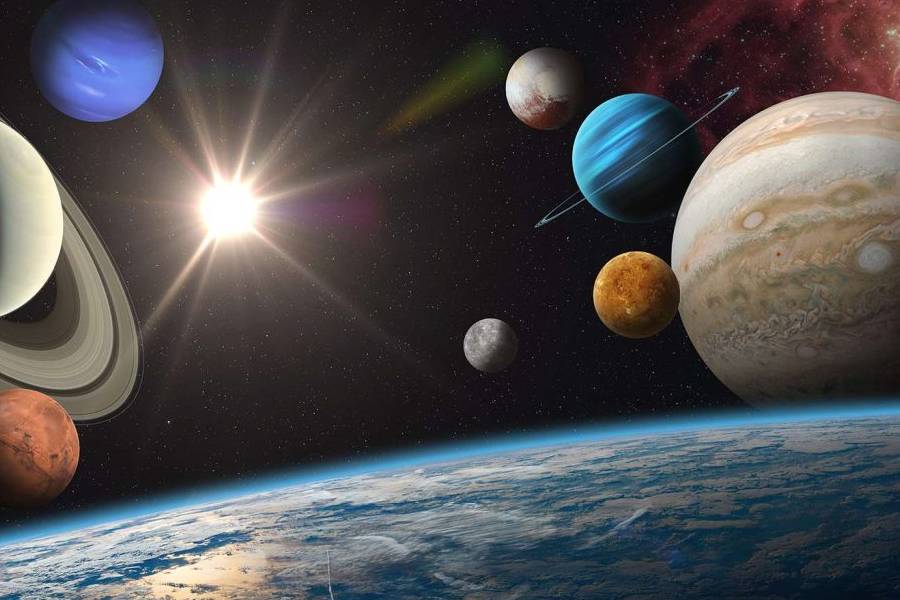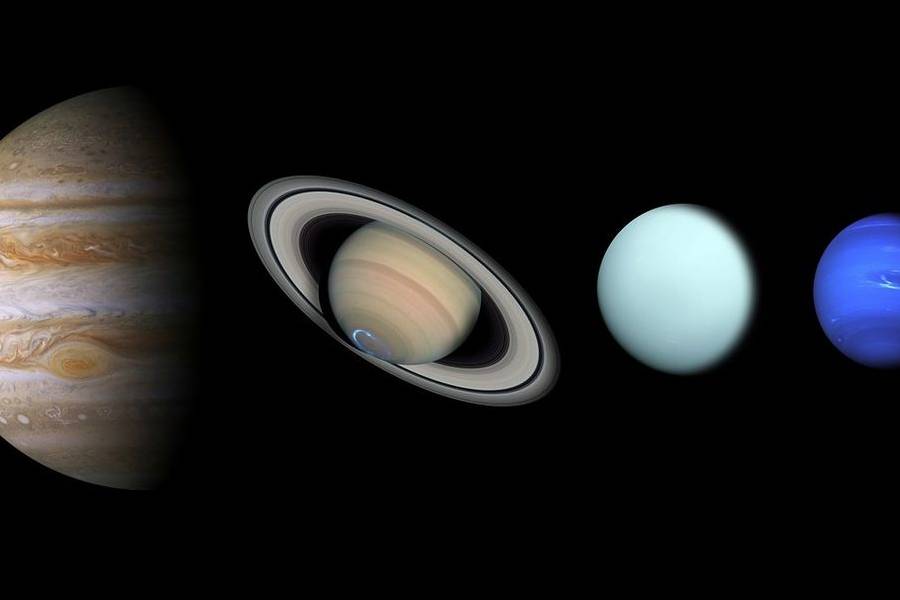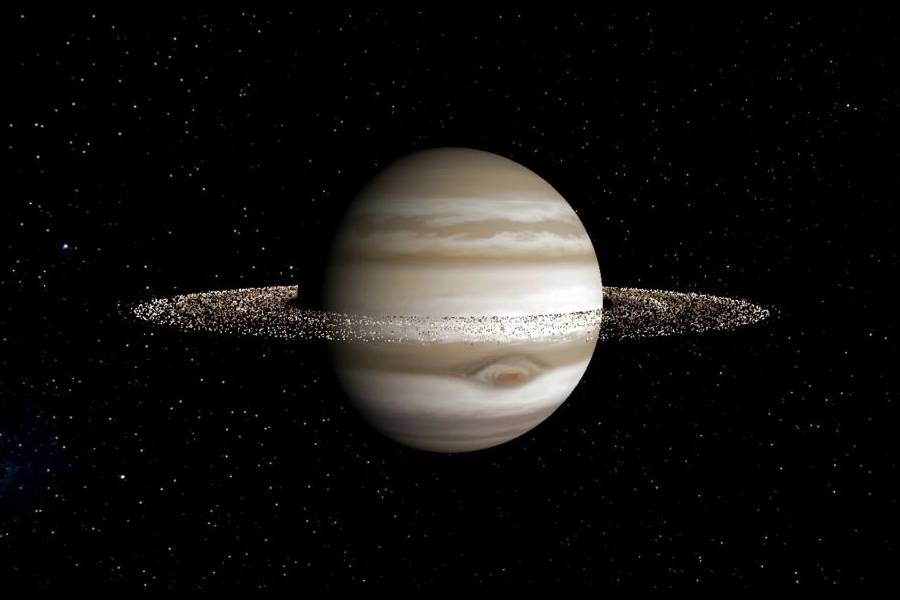With their colossal size, vibrant bands of clouds, and fascinating moons, the Jovian planets have long fueled our curiosity about the vast and diverse realms of our cosmic vicinity. But what are Jovian planets?
In this article, we will unravel the mysteries of Jovian planets, exploring their defining characteristics, composition, and their vital role in our understanding of the cosmos.
From the mighty Jupiter to the ringed beauty of Saturn, the icy giants Uranus and Neptune, and the captivating worlds that orbit them, we’ll uncover the secrets of these massive and mesmerizing giants that inhabit the outer reaches of our solar system.
Let’s get started!

What Are Jovian Planets?
Jovian planets, often referred to as gas giants, stand as some of our solar system’s most enigmatic and colossal members. Named after the mighty Jupiter, these stand in stark contrast to the rocky terrestrial planets that comprise our inner solar system.
They include Jupiter, Saturn, Uranus, and Neptune. These planets are primarily composed of gas and lack solid surfaces. They have thick atmospheres, numerous moons, and fascinating ring systems.
Jovian planets are significantly larger than terrestrial planets and play a crucial role in our understanding of planetary formation and the dynamics of our solar system.
What Are the Characteristics of Jovian Planets?
Size and mass
Jovian planets are the largest planets in our solar system. Their immense size and mass distinguish them from the smaller terrestrial planets like Earth and Mars. To provide a sense of scale, Jupiter, the largest Jovian planet, is more than 11 times wider than Earth and has a mass of 318 times greater.
Composition and atmospheric features
The composition of Jovian planets primarily consists of hydrogen and helium, the two most abundant elements in the universe. Beneath their thick atmospheres, gas giants likely have solid cores, but these cores are relatively small compared to the planet’s overall size
Their atmospheres are characterized by extreme pressures and temperatures, which cause the hydrogen and helium to behave as dense fluids rather than gases.
Distinctive appearance
Jovian planets exhibit distinctive visual characteristics. They are known for their vibrant bands of clouds, massive storms, and iconic features like Jupiter’s Great Red Spot.
Various cloud layers, each composed of different compounds, create a striking and ever-changing appearance. Additionally, some Jovian planets, such as Saturn, are adorned with spectacular ring systems.
What is their role in shaping the solar system?
Jovian planets play a crucial role in shaping the dynamics of the solar system. Their immense gravitational influence affects the orbits of other celestial bodies, including asteroids and comets.
This gravitational pull is often responsible for capturing objects into stable orbits or entirely ejecting them from the solar system. Also, the Jovian planets likely played a significant role in the early solar system’s formation, influencing the distribution of matter and the arrangement of planets.
Types of Jovian Planets
When we explore Jovian planets, we encounter two distinct categories: gas giants and ice giants. Let’s delve into the characteristics that define each group and examine how they differ.
Gas giants
Jupiter: The colossal king of gas giants
- Size and mass – Jupiter reigns as the largest planet in our solar system, with a diameter of approximately 139,822 kilometers (86,881 miles). Its massive bulk comprises roughly 318 times the mass of Earth.
- Composition – Jupiter’s atmosphere is composed of hydrogen (approximately 75%) and helium (about 24%), with trace amounts of other gases and compounds. Its dense atmosphere creates immense pressure and temperature gradients as you descend deeper into the planet.
- Distinctive features – Jupiter’s iconic feature is the Great Red Spot, a colossal storm system that has persisted for centuries. It boasts a complex system of cloud bands and numerous moons, including the four largest Galilean moons: Io, Europa, Ganymede, and Callisto.
Saturn: The ringed wonder
- Size and mass – Saturn is renowned for its stunning ring system, but it’s also the second-largest gas giant in the solar system, with a diameter of approximately 116,464 kilometers (72,400 miles). Its mass is about 95 times that of Earth.
- Composition – Saturn shares a similar composition with Jupiter, primarily consisting of hydrogen (around 75%) and helium (approximately 25%). Its atmosphere exhibits intricate cloud patterns and a hexagonal storm at its north pole.
- Distinctive features – Saturn’s magnificent ring system is its hallmark. These stunning rings are made up of countless icy and rocky particles, forming a complex structure around the planet. Saturn also possesses a diverse family of moons, with Titan being the largest and most intriguing.

Ice giants
Uranus: The sideways ice giant
- Size and mass – Uranus is distinct not only for its bluish hue but also for its peculiar axial tilt. It has a diameter of approximately 50,724 kilometers (31,518 miles) and a mass roughly 14.5 times that of Earth.
- Composition – Unlike the predominantly hydrogen-helium atmospheres of gas giants, Uranus has a more significant proportion of ice, including water, ammonia, and methane. A layer of clouds envelops its atmosphere and exhibits a unique blue-green coloration.
- Distinctive features – Uranus’ axial tilt is extreme, causing it to rotate on its side. It lacks the pronounced cloud bands seen on Jupiter and Saturn but does display subtle cloud patterns. Uranus has a collection of smaller moons and a set of inner rings.
Neptune: The blue beauty
- Size and mass – Neptune is the final planet in our solar system and boasts a diameter of approximately 49,244 kilometers (30,598 miles). Its mass is nearly 17 times that of Earth.
- Composition – Neptune shares similarities with Uranus regarding its ice-rich composition. It possesses an atmosphere rich in hydrogen, helium, methane, and other compounds. Its vivid blue coloration is attributed to the presence of methane in its upper atmosphere.
- Distinctive features – Neptune’s most recognizable feature is its Great Dark Spot, a storm system similar to Jupiter’s Great Red Spot. The planet exhibits cloud bands and high-velocity winds. Neptune’s moon Triton is of particular interest, as it orbits the planet in a retrograde direction, suggesting a captured object.
Comparison of gas and ice giants
Gas giants like Jupiter and Saturn are characterized by their massive sizes, predominantly hydrogen-helium atmospheres, and intricate cloud systems. They exhibit well-defined cloud bands and often feature prominent storms.
In contrast, ice giants like Uranus and Neptune have smaller diameters, significant proportions of ice in their atmospheres, and distinct bluish appearances. They lack the prominent cloud bands of gas giants but may display subtle cloud patterns.
Formation and Composition of Jovian Planets
Understanding the formation and composition of Jovian planets is crucial to unraveling their mysteries and their roles in our solar system’s dynamics.
Birth of Jovian Planets
Jovian planets, also known as gas giants, were born in the early stages of our solar system’s formation alongside the Sun. Their formation process can be summarized as follows:
Nebular Collapse
Like all celestial bodies in the solar system, Jovian planets originated from a massive cloud of gas and dust called the solar nebula. Gravitational forces caused regions within the nebula to collapse.
Accretion of gas and dust
As these regions collapsed, they formed dense cores, which served as the seeds for Jovian planets. These cores began to accrete gas and dust from the surrounding nebula.
Runaway gas accretion
Once the cores reached a critical mass, their gravitational pull became strong enough to attract vast amounts of hydrogen and helium gas. This phase of rapid gas accretion led to the formation of the massive gas envelopes that define Jovian planets.
Composition of Jovian atmospheres
The atmospheres of Jovian planets are complex, primarily composed of hydrogen and helium, but also containing various trace elements and compounds.
Hydrogen and helium dominance
- Hydrogen (H2) – Hydrogen is the most abundant element in the universe and dominates the atmospheres of Jovian planets. It is the primary component, accounting for about 75-90% of their composition.
- Helium (He) – Helium is the second most abundant element in the universe and constitutes a significant portion of Jovian atmospheres, typically around 10-25%.
Trace elements and compounds
- Methane (CH4): Methane is present in small but essential quantities in Jovian atmospheres. It contributes to the distinct colors and cloud patterns seen on these planets.
- Ammonia (NH3): Ammonia is another trace compound found in Jovian atmospheres, influencing their chemistry and cloud formation.
- Water vapor (H2O): While water vapor is not as abundant as hydrogen and helium, it plays a role in Jovian weather systems, especially in the deeper layers of their atmospheres.
- Trace elements: Jovian atmospheres may contain trace amounts of other elements such as methane, ammonia, water, and sulfur compounds.
Stormy weather
Jovian atmospheres are known for their turbulent and dynamic weather systems, characterized by massive storms and distinctive cloud bands.
- Cloud bands – Gas giants exhibit prominent cloud bands, with alternating light and dark stripes encircling the planet. These bands result from differences in temperature, composition, and wind patterns at different altitudes.
- Great red spot – Jupiter, in particular, boasts the iconic Great Red Spot, a colossal storm system that has persisted for centuries. It is a high-pressure anticyclonic storm with distinctive reddish hues.
- Storms and winds: High-speed winds and numerous storms mark the atmospheres of Jovian planets. These storms can vary in size and intensity and are driven by the planet’s rapid rotation and heat from its interior.

Moons and Rings of Jovian Planets
Jovian planets are not only known for their immense size but also for their fascinating entourages of moons and intricate ring systems.
Rings
Saturn’s spectacular rings
Saturn is renowned for its spectacular and extensive ring system. These rings are not solid but are composed of countless small particles, ranging from tiny grains to larger chunks of ice and rock. The rings are divided into several major ring groups, such as A, B, and C rings, each with unique properties.
Ring origins
The precise origins of these rings are still a subject of scientific investigation. Some theories suggest that they are remnants of shattered moons or material that never coalesced into larger bodies due to Saturn’s powerful gravitational forces.
Moons
Varying moon counts
Each Jovian planet has its retinue of intriguing moons. For instance, Jupiter has over 80 known moons, including the four largest known as the Galilean moons: Io, Europa, Ganymede, and Callisto.
Saturn boasts over 80 moons as well, with its largest, Titan, being one of the most intriguing objects in the solar system. Uranus has 27 known moons, while Neptune has 14.
Diverse characteristics
These moons come in various sizes, shapes, and compositions. Some, like Ganymede and Titan, are larger than Mercury and have their atmospheres, while others are irregularly shaped and much smaller.
Some moons exhibit active geological processes, such as cryovolcanism on Enceladus and a subsurface ocean on Europa.
Weather patterns
Jovian planets are known for their turbulent and dynamic atmospheres, which host some of the most extreme storms in the solar system. Jupiter’s Great Red Spot, a massive anticyclonic storm, is a prime example. These storms result from the complex interplay of atmospheric gases and rapid planet rotation.
Unlike Earth, where seasons are primarily caused by axial tilt, the seasons on Jovian planets are not determined by axial tilt but are influenced by their distance from the Sun.
Jupiter, Saturn, Uranus, and Neptune experience subtle variations in temperature and sunlight intensity as they orbit the Sun. However, these changes are not as pronounced as Earth’s seasons.
Discovery of exoplanetary
Beyond our solar system, astronomers have discovered exoplanets that share similarities with Jovian planets. These exoplanets are massive gas giants orbiting distant stars. They are often called “hot Jupiters” when they are close to their parent stars.
Studying exoplanetary Jovian provides valuable insights into planetary formation and the diversity of planetary systems in the universe. These gas giants challenge our understanding of how planets form and evolve, and their detection methods have paved the way for exoplanet research.
Observations of exoplanetary Jovian allow scientists to analyze their atmospheres, providing crucial data about chemical compositions, weather patterns, and the potential for habitability on exoplanets.
Frequently Asked Questions
What makes a planet Jovian?
Jovian planets are characterized by their enormous size and predominantly gaseous compositions. They primarily comprise hydrogen and helium, with trace elements and compounds in their atmospheres.
Is Earth a Jovian Planet?
No, Earth is not classified as a Jovian planet. Instead, Earth belongs to a category of planets known as terrestrial or rocky planets.
Terrestrial planets are smaller, have solid surfaces, and are composed of rock and metal. Earth’s composition and characteristics, such as its surface and atmosphere, differ significantly from Jovian planets.
What are the key differences between gas giants and ice giants among Jovian planets?
Gas giants, represented by Jupiter and Saturn, are primarily composed of hydrogen and helium and have no solid surfaces. They have extensive atmospheres and often feature spectacular ring systems.
In contrast, ice giants, represented by Uranus and Neptune, have a significant portion of their composition as ice, including water, ammonia, and methane. They also have solid cores. The key difference lies in their chemical composition and internal structure, with ice giants having a more substantial ice content than gas giants.
Conclusion
What are Jovian planets? The question leads us to explore these colossal solar system members distinguished by their massive sizes, predominantly gaseous compositions, and dynamic atmospheres.
They are important in shaping our solar system’s dynamics. Their unique features, including vibrant cloud bands, massive storms, captivating moons, and intricate ring systems, have captivated our curiosity.
As we explore their characteristics, formations, and compositions, we gain profound insights into the diverse realms of our celestial neighborhood. These gas giants, along with their icy counterparts, the ice giants, reveal the fascinating complexity of planetary systems and continue to pique the interest of astronomers and researchers alike.
